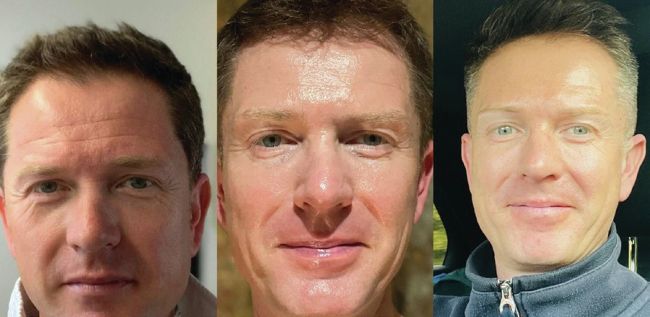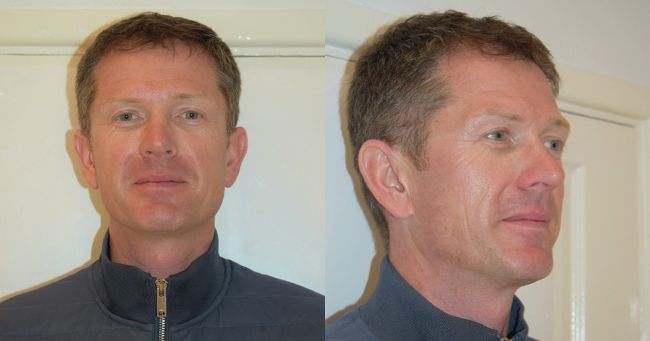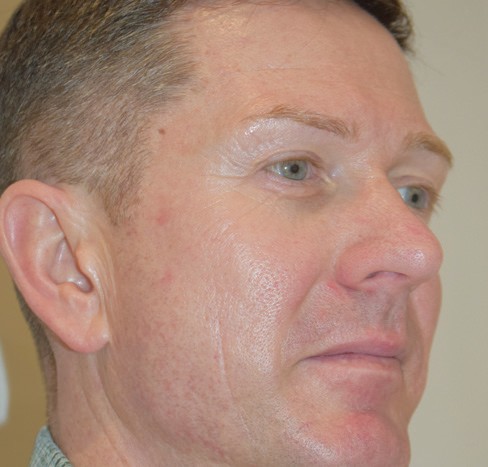CASE STUDY
CASE STUDY: MALE SKIN TRANSFORMATION
Independent nurse prescriber Yuliya Culley discusses a multi-modality approach to creating a long-term, consistent and structured skin management plan for a male in his mid-40s who wanted to improve the texture and appearance of his skin
PATIENT OVERVIEW
Patient: male
Age: 44
Practitioner: Nurse Yuliya Culley
Product intervention: multi-modality + injectables
Intervention goal: subtle rejuvenation

Patient progress selfies
Men are increasingly seeking treatments to address skin damage and ageing without resorting to invasive procedures which might unnaturally change their appearance. The latest iterations of energy-based devices, regenerative treatments and effective, clinical-grade, topical skincare offer all patients, and particularly men, a subtle but effective approach to revitalised skin.1,2
CASE STUDY
Prior to presenting at my Novello Skin clinic in 2023, this 44-year-old patient attended a London practice for minor aesthetic treatments, such as muscle relaxant injections and occasional skin boosters. However, concerned about a lack of consistency in his treatment and aftercare, he asked me to create a bespoke treatment and skincare regime, which he could commit to for the long term.
The patient was fit and healthy and maintained a good diet and exercise routine. However, he works outside for long hours – often every day – in all weather conditions. His objective was to preserve a natural appearance while achieving fresher, more vibrant skin.
At his initial consultation, I observed enlarged pores, static lines across his forehead and periocular area, erythema across his cheeks as a result of sun damage, with some telangiectasia, mild mid-face volume loss and mid-cheek lines caused by soft tissue sagging. Because of his busy lifestyle, I focused on creating a continuing, sustainable, in-clinic and at-home treatment plan that we could review regularly.
TREATMENT PLAN - PHASE 1: SKIN PREPARATION
Prior to embarking on in-clinic treatment, I stabilised his at-home skincare regime with the ZO Skin Health Daily Program for eight weeks, then introduced ZO Wrinkle + Texture Repair 1% retinol at night, along with ZO Firming Serum for the four weeks prior and following in-clinic procedures. He also began to apply SPF 50 every day to protect his skin from any further sun damage.
PHASE 2: COLLAGEN STIMULATION
At week six of his clinical-grade skincare, he began his course of three sessions of microneedling with radiofrequency3 using Cutera’s Secret RF at four-week intervals4,5.
• Session 1: 40% energy level using a 25-pin, semi-insulated needle, with two to three passes at variable depths: Forehead -1.2 - 0.5mm; Periocular – 1.5 -0.8mm; Mid-cheek – 2.5 – 0.5mm; Lower face – 2-0.5mm; Submental and neck areas – 2 – 0.5mm.4,6,7
• Sessions 2 & 3: 50% energy, while maintaining the treatment depths to each area.4,5
PHASE 3: VOLUME RESTORATION
Following his course of microneedling with radiofrequency, in 2024, the patient received Ellansé M dermal filler for immediate volume correction and to stimulate his natural collagen production.8 I used a total of 3ml of filler for his mid and lateral cheeks – including his zygomatic arch and preauricular areas – to restore structural support at the subcutaneous level to achieve a subtle lift.
PHASE 4: POLYNUCLEOTIDES
To optimise skin regeneration and restoration on a cellular level, I then prescribed Polynucleotides Plinest Mastelli 20mg/ml in three sessions at three weekly intervals for his forehead, periocular region and cheeks9,10 prior to a CO2 laser treatment. Polynucleotides offer anti-inflammatory and wound-healing properties, DNA repair and collagen synthesis – helping to increase skin regeneration.
PHASE 5: CO2 FRACTIONAL LASER FOR ADVANCED SKIN RESURFACING
In March 2025, the patient received Secret PRO Ultra CO2laser resurfacing. The patient’s skin was prepared with a topical anaesthetic of 4% Lidocaine (LMX4), 30 minutes prior to his procedure, followed by Clinisept. He wore laser goggles to protect his eyes. I had administered a patch test five days prior to the main treatment session. The treatment itself comprised an energy setting of 42mJ and a laser density setting of 1mm, consisting of two passes in square and diamond patterns11 to his full face; one pass of 42mJ, with 50% overlapping to his periocular area and a single pass to his neck using a scattered laser pattern.11
Following his treatment, I applied Exosomes EvoCyte SRLV topically to accelerate skin healing, reduce inflammation, enhance tissue regeneration, promote collagen synthesis and repair damaged cells.4,12
AFTERCARE
Following most of his procedures, the patient’s aftercare mainly centred on his consistent use of SPF 50, good hydration, and avoiding excessive temperatures, such as saunas, steam rooms and direct sun exposure.5,11,13
In addition, in the three days following his CO2 fractional laser treatment, he was advised to cleanse using only water on the day of his treatment, followed by a mild gel cleanser on the days following to keep his skin moist at all times.5 He used Biafine emulsion to maintain his skin barrier, along with SPF 50. I also advised him to avoid exercise, excessive heat and direct sun exposure until full recovery approximately seven to 10 days post treatment.11 I reviewed him at one and four weeks post treatment to monitor healing and adjust his skincare, as necessary.

Before

After
ONGOING MAINTENANCE & FUTURE TREATMENT PLANNING
The patient continues to have Hydro-O2 facials every eight to 12 weeks. We repeat the microneedling with radiofrequency every nine to 12 months. I also review his skin needs every four months, adjusting his medical-grade, at-home skincare to ensure consistent progress.
We plan to maintain his results using a combination of treatments including:
• Hydro-O2 facials with Excel V+ Laser Genesis for collagen stimulation and redness control
• Ellansé M dermal filler if volume loss reoccurs
• Six-monthly polynucleotides treatment to maintain skin regeneration The patient is also open to other treatments, including skin boosters and Laser Genesis, but is pleased with the results of his current treatments at this stage
THE RESULTS
The combination of clinical-grade skincare and in-clinic treatments have improved the texture and elasticity of the patient’s skin. The patient is highly satisfied with is results, saying he frequently receives compliments on his skin and has referred multiple clients to the clinic as a result.
CONCLUSION
Clinics should be mindful that energy-based devices constitute a significant investment both in terms of the initial outlay and ongoing maintenance costs, meaning they should be a considered purchase that will appeal to an existing client base.
However, taking an integrated approach – combining energy-based devices with regenerative injectables- supports long-term results that encourage ongoing patient engagement.2,3,13,14 This creates sustainable practice revenue, while delegating treatments to other, qualified members of my team creates cost-effective continuity of care that helps to foster better patient-clinic relationships.
Scan for references:
YULIYA CULLEY RGN, INP, BSC, MSC
Yuliya Culley is a registered general nurse and independent prescriber. She qualified in 1998, and has general experience in emergency, cardiology and dermatology nursing. She is a member of the Royal College of Nursing (RCN), The British Association of Cosmetic Nurses (BACN) and the Association of Nurse Prescribing (NP). She is clinical director of Novello Skin in Cheltenham, Gloucestershire.